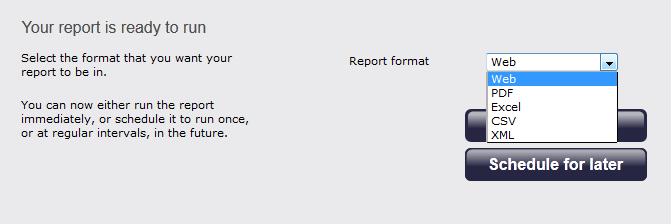Report format
This section allows you to choose the media format of your completed report. To select the preferred format, click on the drop-down list and choose from the available options: Web, PDF, Excel, CSV and XML.

Each of the available formats is described in the table below.
| Format | Description |
|---|---|
The Web format is the default interface for all reports. The results are displayed in a new browser window containing the HTML output generated by the report engine. The report body is shown in a window that can be panned around using the horizontal and vertical scrollbars. If the report is made up of multiple pages, you can navigate through it by clicking on the Universally-accessible, this format provides click-able column headers for dynamic sorting of table data and clean graphical charts in Flash format, enabling you to zoom in for more detail. | |
(Portable Document Format) | The PDF format is useful for producing reports like phone bills or when the report has to be distributed via e-mail to colleagues inside and outside your organisation, as it guarantees they'll look identical across all operating systems when viewed on the screen or printed out. Due to the nature of the format, headers are fixed and not selectable as in the Web reports above; you may, however, presort the results before running or scheduling the report, using the filters available. |
| The Excel format of the report is useful for data manipulation or if you want to integrate this with other Excel spreadsheets. | |
(Comma Separated Values) | A CSV file is used for the digital storage of data, structured in the form of a table of lists. CSV files are often used for moving tabular data between two different computer programs, for example between a database program and a spreadsheet program. The CSV report format is ideal for interacting with your own back-office systems. All CSV data is fully customisable using XSLT from the report's original XML format. |
(Extensible Markup Language) | XMLs purpose is to aid information systems in sharing structured data, especially via the internet, to encode documents and to serialise data. Since all reports are derived from this native format, the XML format contains detailed information about your call logging data so you can extract this into your favourite reporting packages, such as Business Objects, Crystal Reports, or even your favourite Office spreadsheet. |
Run or schedule the report
This is the final screen of the report wizard. Click on the button to run the report immediately, or select the button to schedule the report to run at a later time. To revise the report parameters you have entered, click on the button, which will lead you to the previous report options.
 ,
,  ,
,  or
or  icons at the top-right corner of the screen. You can also print the report by clicking on the
icons at the top-right corner of the screen. You can also print the report by clicking on the